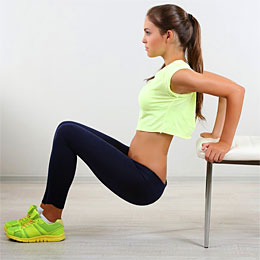- Like
- SHARE
- Digg
- Del
- Tumblr
- VKontakte
- Flattr
- Buffer
- Love This
- Save
- Odnoklassniki
- Meneame
- Blogger
- Amazon
- Yahoo Mail
- Gmail
- AOL
- Newsvine
- HackerNews
- Evernote
- MySpace
- Mail.ru
- Viadeo
- Line
- Comments
- Yummly
- SMS
- Viber
- Telegram
- JOIN
- Skype
- Facebook Messenger
- Kakao
- LiveJournal
- Yammer
- Edgar
- Fintel
- Mix
- Instapaper
- Copy Link
 Part 2 – No Gym, No Problem: House Room Circuit Training
Part 2 – No Gym, No Problem: House Room Circuit Training
In this second part of the “No Gym, No Problem” series, we will introduce a new concept for home workouts that you will want to include in your training program even if you do go to a gym. First, let’s take a look at why some of your best workouts ever can be experienced at home.
Major Advantages of Home Workouts
- How many times have you gone to the gym and forgot your headphones only to suffer through that bubblegum rock they play at the gym and get a sub-par workout? At home you can listen to whatever music you like, as loud as you like, for a high-intensity workout!
- Do you have to rush to the gym after work to be able to get in a workout before it closes? Unlike many local gyms, your home is always open 24 hours a day, 7 days a week, 365 days a year.
- How many times have you had to wait in line at the gym for your favorite cardio or exercise machine at the gym? There are no lines or annoying people hogging up the equipment at home.
The above reasons alone make your home a very desirable gym alternative, but here is another that will add a new level of enjoyment and interest to your workouts: House Room Circuit Training!
House Room Circuit Training means assigning each room in your house a different exercise and moving from room to room performing them one after the other. How your house’s floor plan is laid out will dictate to some degree the order you do the exercises in, but here is one example of how it could be done and you can customize it to best fit your home.
Sample Custom Circuit Training Workout Routine for Home
Living Room (Crunches)
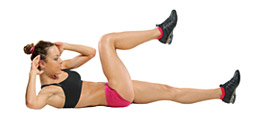 You can start from any room in the house, but in this example we will start in the living room. One piece of furniture usually in a living room is a couch or coffee table. Lay on the floor and put your feet up on the couch or table so your calves are parallel to the floor and you are in a good position for crunches. When performing crunches it is best to just place your hands to the side of your head and resist the temptation to interlock them behind your head to use them to help pull you up. You want to concentrate on just using the abdominal muscles to pull you up till your shoulders come up off the ground and then exhale and contract the abdomen at the top before lowering back down with control. Perform your set amount and quickly move to the next room’s exercise. (See video below)
You can start from any room in the house, but in this example we will start in the living room. One piece of furniture usually in a living room is a couch or coffee table. Lay on the floor and put your feet up on the couch or table so your calves are parallel to the floor and you are in a good position for crunches. When performing crunches it is best to just place your hands to the side of your head and resist the temptation to interlock them behind your head to use them to help pull you up. You want to concentrate on just using the abdominal muscles to pull you up till your shoulders come up off the ground and then exhale and contract the abdomen at the top before lowering back down with control. Perform your set amount and quickly move to the next room’s exercise. (See video below)
Kitchen/ Dining Room (Chair dips)
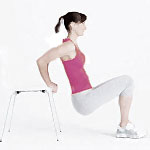 Resist the urge to look in the fridge for a snack, and pull out a kitchen chair from the table. Place your palms behind you on the seat of the chair at about shoulder width apart and walk your legs out in front of you (the further you walk out your legs the more challenging the exercise becomes). With control, keeping your back close to the edge of the chair, lower yourself as far down as you can without causing pain in the shoulders, and then push back up feeling the triceps contract. When you are ready for more of a challenge you can put your feet up on a second chair in front of you and perform the exercise with more of your body weight. Perform your set amount and quickly move to the next room exercise. (See video below)
Resist the urge to look in the fridge for a snack, and pull out a kitchen chair from the table. Place your palms behind you on the seat of the chair at about shoulder width apart and walk your legs out in front of you (the further you walk out your legs the more challenging the exercise becomes). With control, keeping your back close to the edge of the chair, lower yourself as far down as you can without causing pain in the shoulders, and then push back up feeling the triceps contract. When you are ready for more of a challenge you can put your feet up on a second chair in front of you and perform the exercise with more of your body weight. Perform your set amount and quickly move to the next room exercise. (See video below)
Master Bedroom (Pull-ups)
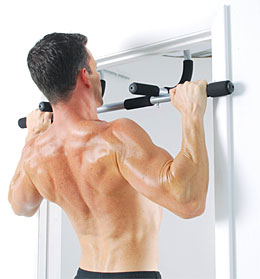 Install a pull-up bar in the door frame of your bedroom. Pull-ups can be done with a variety of grips from narrow to wide, and underhand or over hand. Pull ups are one of the best upper body developing exercises you can do. Choose your variation and perform your set amount of reps before quickly moving on to the next room’s exercise. (See video below)
Install a pull-up bar in the door frame of your bedroom. Pull-ups can be done with a variety of grips from narrow to wide, and underhand or over hand. Pull ups are one of the best upper body developing exercises you can do. Choose your variation and perform your set amount of reps before quickly moving on to the next room’s exercise. (See video below)
Second bedroom (Push-ups/ Inverted Push-ups)
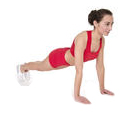 If you have a second bedroom you can make this your push-up station, the perfect compliment to pull-ups as it works all the antagonist muscles to the muscles used in the pull-ups you just did. There are many different variations of push-ups from beginner push-ups on your knees to advanced one-armed and inverted push-ups. If this room is the kid’s room with a bunk bed, you can use the rungs of the ladder to place your feet on for varying degrees of elevated push-ups. Choose a variation that will challenge you, but that you can also execute with good form. (See video below)
If you have a second bedroom you can make this your push-up station, the perfect compliment to pull-ups as it works all the antagonist muscles to the muscles used in the pull-ups you just did. There are many different variations of push-ups from beginner push-ups on your knees to advanced one-armed and inverted push-ups. If this room is the kid’s room with a bunk bed, you can use the rungs of the ladder to place your feet on for varying degrees of elevated push-ups. Choose a variation that will challenge you, but that you can also execute with good form. (See video below)
Bathroom (Squats)
 We can’t forget legs for a complete workout. And I think we all know the feeling of trying to sit down on the toilet the day after a hard leg workout. That’s because sitting down on the toilet is basically the same motion as performing squats. The toilet seat is also a good cue to know when your thighs are parallel or just below parallel to the floor, which is what you should aim for when doing squats. Try not to rest all your weight on the seat to get the best results, just barely touch the back of your thighs and come right back up, pushing through the heels of the feet. Perform your set amount of reps and move on to the next room, or back to the starting room if this completes your circuit. (See video below)
We can’t forget legs for a complete workout. And I think we all know the feeling of trying to sit down on the toilet the day after a hard leg workout. That’s because sitting down on the toilet is basically the same motion as performing squats. The toilet seat is also a good cue to know when your thighs are parallel or just below parallel to the floor, which is what you should aim for when doing squats. Try not to rest all your weight on the seat to get the best results, just barely touch the back of your thighs and come right back up, pushing through the heels of the feet. Perform your set amount of reps and move on to the next room, or back to the starting room if this completes your circuit. (See video below)
Stairs
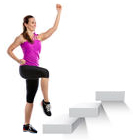 If your house or apartment has stairs, you can definitely take advantage of them to add some HIIT (High Intensity Interval Training) cardio to your circuit. The sample video below will give you some good exercise ideas to add to your circuit.
If your house or apartment has stairs, you can definitely take advantage of them to add some HIIT (High Intensity Interval Training) cardio to your circuit. The sample video below will give you some good exercise ideas to add to your circuit.
You can get very creative when it comes to stair exercises. For example, Spider-man walks are great for all over body development and core strength. To perform this exercise picture yourself scaling a building like Spider-man would except you will be going up an incline. Place both feet at the bottom step, then lean forward and place both hands on the step that comes to about your chest and keep your body up so you are in an inclined push up position facing up the stairwell. Now bring your left foot up to the next step and your right hand up to the next step and then your right foot and left hand, continuing in this way till you reach the top (basically walking up the stairs with your hands and feet) and then see if you can come back down in the reverse way. This might seem easy at first, but if you challenge yourself to see how fast you can climb up and down the steps this way for multiple sets, or even skipping steps, you begin to really feel it. (See video below)
Challenging Variations
- Another challenging way to perform this circuit is in a tabata style workout in which you perform each exercise as many times as you can in 20 seconds, rest 10 seconds, and repeat for 8 sets before moving to the next room.
- Or you could time yourself to see how quickly you can make it through the circuit 5 times and try to beat your time the next day you do the circuit.
- Finally, if you have stairs, try doing 1-3 stair sprints in-between each room’s exercise to add some HIIT into your workout.
Bringing it Home
In this second part of the “No Gym, No Problem” series, we introduced a fun and highly effective workout routine that you can do in the comfort of your own home as you rock out to the tunes of your choice!
Just remember that the example exercises above can be substituted with any of your favorite exercises, and it is always a good idea to change up variations of the exercises to continue to keep your body adapting to new challenges.
Also there are many inexpensive, easy to store, and easy to use exercise equipment you can add to your home gym to increase the variety and effectiveness of your home workouts (e.g., ab roll-out wheels, dumbbells and kettle bells, jump rope, exercise / BOSU balls, etc.)
In the third and final part of this series we will give you workout ideas you can do at the park, a trend that has been gaining in popularity recently as people begin to realize that body weight exercises can be very effective for sculpting chiseled physiques and improving core strength and balance.
See Also:
- Part I – No Gym, No Problem: Staying Fit at the Office
- Ten Fun & Effective Ways to Workout in Your Home
About Dax Tucker
Dax Tucker has over 29 years of weight training experience, a black belt in Tae Kwon Do, and is a tournament chess player and yoga practitioner. He also has an MBA, and a BA in psychology. In June of 2011 he released his first published work, "The Leaf Catcher," that is bound to be a modern classic. "The Leaf Catcher" is written in the style of Dante's Divine Comedy and explores and defines the human mind, body, and soul. Dax is currently married with 3 children, and lives in the Pacific Northwest.

